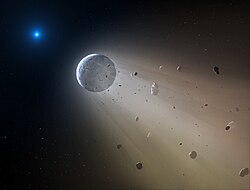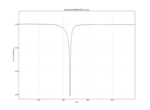Disrupted planet

In astronomy, a disrupted planet[1][2] is a planet or exoplanet or, perhaps on a somewhat smaller scale, a planetary-mass object, planetesimal, moon, exomoon or asteroid that has been disrupted or destroyed by a nearby or passing astronomical body or object such as a star.[1][2] Necroplanetology is the related study of such a process.[3][4]
The result of such a disruption may be the production of excessive amounts of related gas,
uneven ring of dust", causing erratic light fluctuations in the apparent luminosity of the parent star, as may have been responsible for the oddly flickering light curves associated with the starlight observed from certain variable stars, such as that from Tabby's Star (KIC 8462852), RZ Piscium and WD 1145+017.[3][4] Excessive amounts of infrared radiation may be detected from such stars,[6] suggestive evidence in itself that dust and debris may be orbiting the stars.[5][7][8][9]
Examples
Planets
Examples of planets, or their related remnants, considered to have been a disrupted planet, or part of such a planet, include:
.Stars
Examples of parent stars considered to have disrupted a planet include: EPIC 204278916, Tabby's Star (KIC 8462852), PDS 110, RZ Piscium, WD 1145+017 and 47 Ursae Majoris.
uneven ring of dust
" surrounding Tabby's StarTabby's Star light curve
uneven ring of dust" orbits Tabby's Star.[14][15] However, in September 2019, astronomers reported that the observed dimmings of Tabby's Star may have been produced by fragments resulting from the disruption of an orphaned exomoon.[16][17]
-
All light curve data − December 2009 to May 2013, scan days 0066 to 1587 (Kepler)
-
5 March 2011 − day 792
15% max dip (Kepler) -
28 February 2013 − day 1519
22% max dip (Kepler) -
17 April 2013 − day 1568
8% max dip (Kepler) -
Light curve between 10 October 2019 and 11 January 2020 (HAO)[22]
See also
References
- ^ a b Staff (22 December 2017). "Young Star RZ Piscium is 'Eating' Its Own Planets, Astronomers Say". Sci-News.com. Retrieved 23 December 2017.
- ^ a b Fryling, Kevin (21 December 2017). "IU astronomer's analysis helps discover that a star in the constellation Pisces is a 'planet-eater'". Indiana University. Retrieved 23 December 2017.
- ^ a b Starr, Michelle (28 March 2020). "Necroplanetology: The Strangest Field of Astronomy You've Never Heard Of". ScienceAlert.com. Retrieved 30 March 2020.
- ^ S2CID 213004256.
- ^ S2CID 119530135.
- S2CID 14171378.
- ^ Landau, Elizabeth (4 October 2017). "Mysterious Dimming of Tabby's Star May Be Caused by Dust". NASA. Retrieved 23 December 2017.
- S2CID 118875846.
- ^ Tabor, Abby (5 October 2017). "The scientific quest to explain Kepler's most enigmatic find". Phys.org. Retrieved 23 December 2017.
- S2CID 54959652.
- S2CID 14676169.
- S2CID 53960650. Retrieved 25 December 2017.
- S2CID 54859232.
- ^ "Mysterious Dimming of Tabby's Star May Be Caused by Dust". NASA/JPL. Retrieved 13 November 2018.
- S2CID 215751718.
- ^ Columbia University (16 September 2019). "New observations help explain the dimming of Tabby's Star". Phys.org. Retrieved 16 September 2019.
- S2CID 195316956.
- Gary, Bruce L. (14 November 2017). "Hereford Arizona Observatory photometry observations of KIC 8462852". BruceGary.net. Retrieved 24 December 2017.
- Gary, Bruce L. (4 October 2017). "Hereford Arizona Observatory photometry observations of KIC 8462852 between 2 May and 4 October 2017". BruceGary.net. Archived from the original on 4 October 2017. Retrieved 23 December 2017.)
Note: g'-band and r'-band dip depths (and shapes) may differ, with g'-band being more sensitive to dust cloud scattering due to its shorter wavelength (0.47 vs. 0.62 micron). For a reasonable particle size distribution (e.g., Hanson, 0.2 micron) the extinction cross section ratio would produce a depth at r'-band that is 0.57 x depth at g'-band. If g'-band depth is 0.3 %, for example, depth at r'-band could be 0.17 %. The "Tabby Team" measurements (Fig. 3) at r'-band are compatible with that small dip depth. Incidentally, none of these shapes resemble exo-comet tail transits; so the mystery of what's producing these week-timescale dips continues! Actually, long oval shapes are known to produce V-shaped dips (think of rings with a high inclination).
– (as described by Rappaport et al, 2017 link - Gary, Bruce L. (1 January 2018). "Hereford Arizona Observatory photometry observations of KIC 8462852 between 2 May and 31 December 2017". BruceGary.net. Archived from the originalon 2 January 2018. Retrieved 1 January 2018.
- Gary, Bruce L. (4 May 2018). "Hereford Arizona Observatory photometry observations of KIC 8462852 between 2 May 2017 and 4 May 2018". BruceGary.net. Archived from the originalon 5 May 2018. Retrieved 5 May 2018.
- ^ Gary, Bruce (11 January 2020). "KIC 8462852 Hereford Arizona Observatory Photometry Observations #9". Archived from the original on 5 April 2020. Retrieved 5 April 2020.
Further reading
- Wallace Gary Ernst (1990). The Dynamic Planet. Columbia University Press. p. 18. ISBN 978-0-231-07231-1.
- ISBN 978-1-4200-3335-9.
External links
- NASA – WD 1145+017 b at The Extrasolar Planets Encyclopaedia.
- Video (13:46) − "Tabby's Star" on YouTube, a presentation by Tabetha S. Boyajian.
- Video (31:00) − "Tabby's Star" on YouTube, a presentation by Issac Arthur.
- Video (01:00) − RZ Piscium on YouTube, star with unusual light fluctuations (21 December 2017).






![One year light curve − up to 4 May 2018 (HAO[18][19][20][21])](http://upload.wikimedia.org/wikipedia/commons/thumb/5/5d/KIC_8462852_Daily_Normalized_Flux_by_Bruce_Gary%2C_20170502-20180504.png/150px-KIC_8462852_Daily_Normalized_Flux_by_Bruce_Gary%2C_20170502-20180504.png)
![Light curve between 10 October 2019 and 11 January 2020 (HAO)[22]](http://upload.wikimedia.org/wikipedia/commons/thumb/8/8f/KIC_8462852_October-December_2019_Gary.jpg/150px-KIC_8462852_October-December_2019_Gary.jpg)